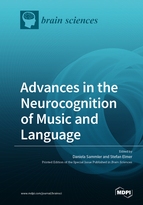Advances in the Neurocognition of Music and Language
A special issue of Brain Sciences (ISSN 2076-3425).
Deadline for manuscript submissions: closed (15 August 2019) | Viewed by 89319
Special Issue Editors
Interests: music cognition and the brain; neurocognitive overlap of music and language; neural bases of prosody
Interests: music training and transfer effects; spectrotemporal speech processing; language learning and expertise; multilingualism; speech, music and cognitive functions; functional and structural plasticity
Special Issue Information
Dear Colleagues,
Neurocomparative music and language research has seen major advances over the past two decades: The Shared Syntactic Integration Resource Hypothesis (SSIRH) has now come of age, fully matured, as has the Modularity of Music Processing, and yet research on the relationship between music and language has never lost its appeal. On the contrary, the field has left no stone unturned to explore neurofunctional similarities of syntax and rhythm, pitch and meaning, their emotional and communicative power, in ontogeny and phylogeny. Research on perceptual and cognitive transfer between domains has recognized the signs of times by exploring learning and cognitive reserve in aging and the benefits of neural entrainment, amongst others. Methods have been refined and the explanatory value of neural overlap has been questioned, all to draw a more nuanced picture on what is shared and what is not, and what this knowledge earns practitioners. The goal of this Special Issue is to take a step back and showcase persistent neural analogies between musical and linguistic information processing and their entwined organization in human cognition, to scrutinize the limits of neural overlap and sharing, and to conclude on the applicability of the combined knowledge in pedagogy and therapy.
Dr. Daniela Sammler
Dr. Stefan Elmer
Guest Editors
Manuscript Submission Information
Manuscripts should be submitted online at www.mdpi.com by registering and logging in to this website. Once you are registered, click here to go to the submission form. Manuscripts can be submitted until the deadline. All submissions that pass pre-check are peer-reviewed. Accepted papers will be published continuously in the journal (as soon as accepted) and will be listed together on the special issue website. Research articles, review articles as well as short communications are invited. For planned papers, a title and short abstract (about 100 words) can be sent to the Editorial Office for announcement on this website.
Submitted manuscripts should not have been published previously, nor be under consideration for publication elsewhere (except conference proceedings papers). All manuscripts are thoroughly refereed through a single-blind peer-review process. A guide for authors and other relevant information for submission of manuscripts is available on the Instructions for Authors page. Brain Sciences is an international peer-reviewed open access monthly journal published by MDPI.
Please visit the Instructions for Authors page before submitting a manuscript. The Article Processing Charge (APC) for publication in this open access journal is 2200 CHF (Swiss Francs). Submitted papers should be well formatted and use good English. Authors may use MDPI's English editing service prior to publication or during author revisions.
Keywords
- Music, speech and language
- Brain
- Neural overlap
- Perception and cognition
- Learning and oscillatory dynamics
- Therapeutic applications, cognitive reserve, and aging








